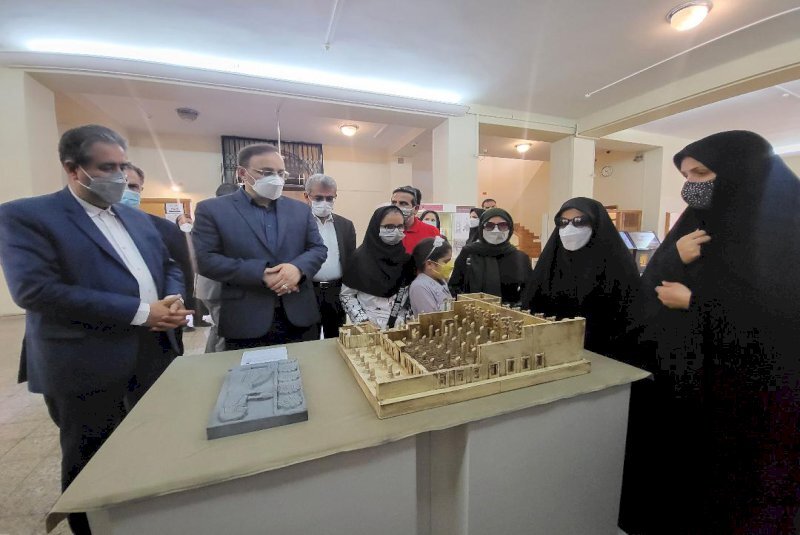Please do touch! Exhibition for blind opens in Tehran

TEHRAN – An exhibition aimed at the visually impaired has opened in downtown Tehran, inviting visitors to touch replicas and enjoy pieces they would normally only read or hear about.
A special project named “Touch the History” launched at the prestigious National Museum of Iran on Sunday in a push to make its offerings more accessible and enjoyable for the blind.
The opening ceremony was attended by a host of blind and partially-sighted people from all age groups in the presence of some officials from the Ministry of Cultural Heritage, Tourism, and Handicrafts.
“The significant point and what makes this exhibition different from similar events is the cultural sequence of its objects that range from nine thousand years ago to the Islamic period,” said Jebrael Nokandeh, director of the National Museum, addressing participants at the opening ceremony.
“In this exhibition, blind visitors are offered to feel the identity and culture of Iran by touching numerous models of historical sites and relics.”
The works have been made exclusively to help the blind to understand the form from the one hand, and perceive embossed motifs and decorations from the other hand, the official explained.
Moreover, Nokandeh talked about the event as an example of social responsibility, saying “Such an event shows the social responsibility of museums towards people with disabilities.”
The museum director reminded the attendees of the International Museum Day, saying “Simultaneously with this year’s theme ‘The Power of Museums’, the National Museum of Iran hopes its new mission will encourage the awareness of the audience and visitors more than before.”
Moreover, the museum is going to install Brail labels beside some of its relics, he said.
“This allows the blind to use the museum on an equal footing with other visitors, and ordinary audiences. Especially children and adolescents will be able to experience a different sense of touch to have a deep connection with objects by touching these models.”
It is estimated that approximately 2.2 billion people have a vision impairment or blindness, according to the Worth Health Organization (WHO), a billion of who have either not had their condition addressed, or whose impairment could have been prevented.
According to Iran’s health ministry, there are around 30,000 visually-impaired children and some 7,500 blind children in the country. Furthermore, it is estimated that Iran is home to more than 80,000 blind people of 50 years old and above.
In 1993, the association of visually-impaired persons was established in Iran to help them maintain and boost activity in society. The association offers rehabilitation and welfare services to improve life skills, living conditions, and education for the target community.
National Museum is a state museum under the auspices of the Ministry of Cultural Heritage, Tourism, and Handicrafts. The Museum consists of the Iran Bastan Museum (Ancient Iran) and the Museum of Islamic Archaeology and Art of Iran, as well as eight research departments, the conservation department, the library, and the archives. The research departments are organized by specific archaeological and historical periods and topics.
Moreover, it has the largest collection of archaeological objects in the country. Dating from the Paleolithic to the late Islamic period, the collections represent more than a million years of human settlement and cultural achievement in Iran. It showcases ceramics, pottery, stone figures, and carvings, mostly taken from excavations at Persepolis, Ismail Abad (near Qazvin), Shush, Rey, and Turang Tappeh to name a few.
The Paleolithic personal ornaments, clay and human figurines from the early village communities, the earliest evidence of administrative technology and writing from the 4th millennium BC, Persepolis stone reliefs and capitals, Parthian life-size bronze statue of the “Shami Man”, the natural mummy of a man called “Salt Man,” the Ilkhanid Mihrab (prayer niche) of Dar-e Behesht, and the pen and ink (Siah Qalam) paintings by Reza Abbasi of the Safavid period are among the important objects in the museum.
Inside, among the finds from Shush, there’s a stone capital of a winged lion, some delightful pitchers and vessels in animal shapes, and colorful glazed bricks decorated with double-winged mythical creatures. A copy of the diorite stele detailing the Babylonian Code of Hammurabi, found at Shush in 1901, is also displayed – the original being in Paris.
The main building of the National Museum, designed by French architect André Godard and completed in 1928, is one of the more attractive modern buildings in Tehran, blending Sassanian principles such as the grand iwan-style entrance with art deco–style brickwork.
According to organizers, “Touch the History” will be running through June 30.
AFM
Leave a Comment